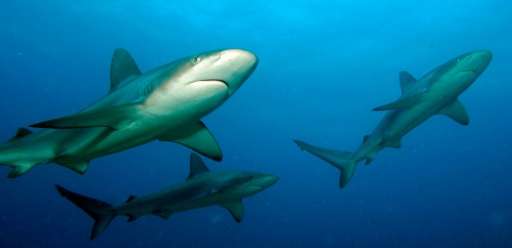Cuban, US scientists bond over big sharks

Somewhere in the North Atlantic right now, a longfin mako shark—a cousin of the storied great white—is cruising around, oblivious to the yellow satellite tag on its dorsal fin.
In mid-July, that electronic gizmo should pop off, float to the surface and instantly transmit a wealth of data to eagerly awaiting marine scientists in Cuba and the United States.
How the mako became one of the first sharks ever to be satellite-tagged in Cuban waters is the subject of an hour-long documentary that is a highlight of Discovery Channel's cult summer series Shark Week.
"Tiburones: Sharks of Cuba" marks the first time that TV cameras have recorded American and Cuban scientists working side by side to explore the mysteries of shark behavior, habitats and migration.
It also comes as Cuba and the United States renew full diplomatic ties, more than five decades after Fidel Castro's communist revolution.
"The Caribbean has, I think, 20 percent of the world's biodiversity of sharks and Cuba is the heart of that," the show's director Ian Shive told AFP by telephone from Los Angeles.
What's more, a half-century of isolation and limited development mean Cuba's coral waters have largely escaped the kind of negative environmental impact seen elsewhere in the region, Shive said.
"The oceans surrounding Cuba are like time capsules," he said. "You can go back and look at the Caribbean as it was 50 years ago."
Inspiring the project was a shark of legend—El Monstruo, or The Monster, a great white caught by fishermen off the Cuban village of Cojimar, east of Havana, 70 years ago.
Biggest ever
Reputedly 21 feet long (6.4 meters) long and weighing in at 7,000 pounds (3,175 kilograms), it remains perhaps the biggest great white ever captured anywhere in the world.
"All the fishermen and their families came down. They were excited because they had never seen such a big animal in Cojimar," fisherman Osvaldo Carnero, a young boy at the time, told the filmmakers.
Tagging a similar big shark was one of the goals of the 15-day expedition in February that brought together shark experts from Cuba's Center for Coastal Ecosystems Research and Florida's Mote Marine Laboratory as well as Shive's camera crew.
They found initial success along Cuba's south coast in a pristine coral reef system known as the Gardens of the Queen, once visited by Christopher Columbus and now one of the Caribbean's biggest marine parks.
There they successfully tagged two large silky sharks with help from veteran Cuban diver Noel Lopez Fernandez, who wrangled them underwater with his bare hands and then rubbed their bellies to sedate them.
Surprising data has already been received from the silkys, Robert Hueter, Mote's associate vice president for research, told AFP in a telephone interview from Sarasota, Florida.
Not only do they prefer to stay near the reef, the satellite tags—which measure sea depth as well as location—revealed that the sharks can dive as far down as 2,000 feet (610 meters), much deeper than assumed for the species, Hueter said.
From the Gardens of the Queen, the scientists set off for Cojimar and struck it lucky by snagging the longfin mako, with top shark cinematographer Andy Casagrande underwater capturing video of the rarely seen oceanic creature.
Only the second
It is only the second longfin mako to be sat-tagged, Hueter said. The first, in 2012, roamed from the Gulf of Mexico and around Florida before turning up in the Chesapeake Bay in Maryland, on the US East Coast.
Hueter is hoping for the so-called "pop-up" satellite tag, worth about $4,000, to come off the shark and commence its data dump sometime in mid-July.
"Everyone's eager to get that data," said Shive, who recalled the two years it took to get US permission to go to Cuba and for Havana to green-light the first-ever satellite tagging of its sharks.
Hueter is hopeful that better relations between Washington and Havana will facilitate more joint projects between Florida-based scientists and their Cuban counterparts just 90 miles away.
"In some ways (the February expedition) was the culmination of a lot of work, and in other ways it was the starting point for what will hopefully be a new age of cooperation between the United States and Cuba," he said.
"Tiburones: Sharks of Cuba" premieres Tuesday in the United States. Discovery Channel, which launches its 28th annual Shark Week on Sunday, plans to air the show in other countries in the coming months.
© 2015 AFP














